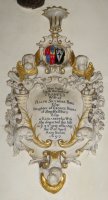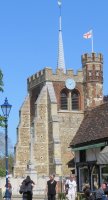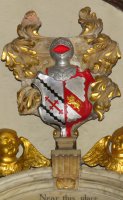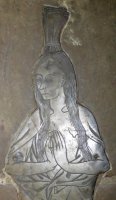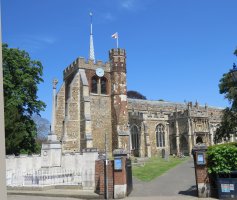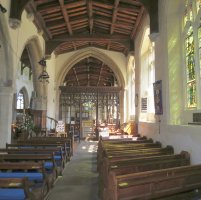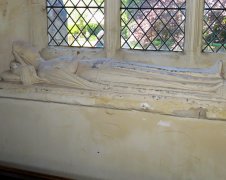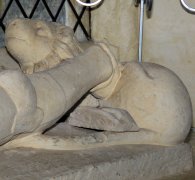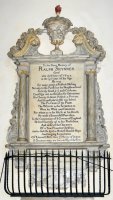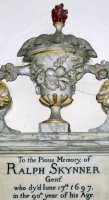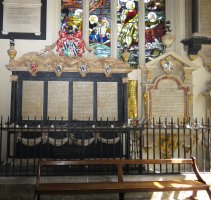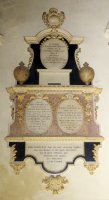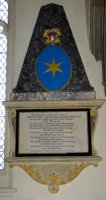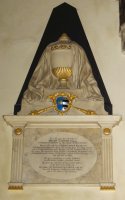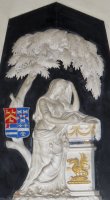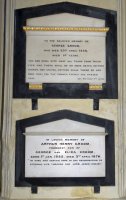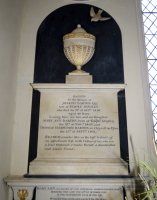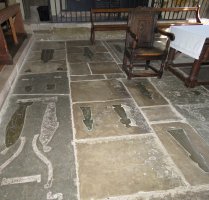St Mary's Church, Hitchin - Monuments in 10 Minutes
A 10 minute look at monuments in St Mary's Church in Hitchin. We have 3 medieval effigies of knights and a lady, and among the 30 or so wall panels are splendid 18th Century marble monuments to the Radcliffe family, tall obelisk monuments, and white-on-black 19th Century panels including a figure of a mourning girl, as well as several ancient brasses.
This page is for visitors to Hitchin, Hertfordshire who only just have time for a quick visit to the Church and its monuments, in a rush, and gives a 10 minute visit version of what you should look out for. Church monuments and churches in general deserve a long, leisurely exploration, and if you do have more time or may come back for another visit to enjoy the monuments more carefully, then see this fuller page.
Hitchin Church, St Mary.
First, the Church itself as we see it today is mostly 15th Century, including most of the exterior, the splendid roofs inside, and much of the woodwork and furnishings, including an elaborate font, screens, and brasses. The oldest work is the tower, 12th Century lower down, with a corner or newell tower of the 13th Century.
The oldest monuments are three reclining figures, quite battered and today found rather unglamorously on the windowsills. Worth looking at as they are older than anything else in the Church, and depict medieval knights and a lady. Battered as they are, we can still see the 14th Century lady's slender figure (see picture above left, click to enlarge), the elegant cut of her robes, the fashionable lap-dogs at her feet. She may be Elizabeth Kendall, and the chain-mailed knight may be her husband Edward Kendale, who both died in the 1370s, and derived from a noble family originating in Kendal in Cumbria. The man in plate armour is older still, 13th Century or maybe 12th Century so as old as the oldest part of the Church, and while his identity is speculative, the statue came from a Knight Templar stronghold in nearby Temple Dinsley, and is thought to be a member of the Baliol family, perhaps Bernard de Baliol. Rather than being shoved on windowsills, once these figures would likely have rested on altar tombs, of which there are three (with brasses rather than figures) in the Church, of similar age to the statues or a bit younger.
Sculptor William Stanton's work.
The earliest wall panels in the Church are to the Skynners: that to Ralph Skynner, d.1697, is a black and white marble piece retaining its iron railing, and has elaborate carving of flowers and fruit, by an important British sculptor, William Stanton. Another Stanton piece is hidden by the organ. We do have a cartouche monument - a broadly oval wall panel with a wide border of scrolls, flowers and fruit, three winged cherub heads and two jawless skulls - to Ralph Skynner's wife, Frances [Nodes] Skynner (see picture at top of page, click to enlarge and see detail).
Lords of the Manor, 18th Century: Radcliffe monuments.
The monuments to a later family who were Lords of the Manor of Hitchin, the Radcliffe monuments, have a wall to the South Chancel to themselves. The four panels and their surround date from 1675, and sport a showy canopy made up of four interlinked curved pediments, each with a shield of arms within a cartouche, with a much bigger coat of arms carved above. Around it are four large 18th Century wall monuments, grand Classical pieces, with pediments above, and a variety of carved cherub heads, funereal urns, festoons of flowers, and heraldic shields, along with different, costly marbles.
Obelisk monuments in Hitchin Church.
Obelisk monuments, with a tall black obelisk at the top to give height and dignity, as well as hearkening to the Egyptian obelisks associated with honouring the dead, are well represented in the Church, with monuments to the Ithell, Carter, Tristram, Whitehurst and Hinde families: the piece to Robert Hinde, d.1828, is a must-see in the Church, and includes a carved girl mourning against a casket tomb raised on a plinth. She rather irreverently leans her elbow on the top, and lounges cross-legged rather than stands - this style of figure was popularised a little earlier, around the 1790s-1800s, by famous sculptors of the time including Flaxman and John Bacon: the example here is by a gifted but much less familiar sculptor, William Chadwick of Southwark. More about obelisk monuments on this page.
19th Century white-on-black panels.
The 19th Century wall panels tend to a simpler style with no or little carving, and are recognisable as white-on-black panels, several cut as if they were tomb chests seen side on - so the inscribed panel has a shelf and 'lid' pediment on top, and little feet below, seen in the Whittington, Radcliffe, Groom (picture above left) and Hawkins tablets. A couple include carving and have a vertical format, being those to Joseph Darton, d.1816, with a carved pot (picture above right), and Joseph Pierson, d.1842, with a draped chest on top (lots more on white-on-black monuments on this page).
Make sure too to look at the brasses on the floor, of which Hitchin has a good collection, dating mostly from the 15th Century (examples below and at top of page, click to enlarge).
Fuller page on the monuments in the Church: click here.
The Church website is at https://www.stmaryshitchin.co.uk/about/.

